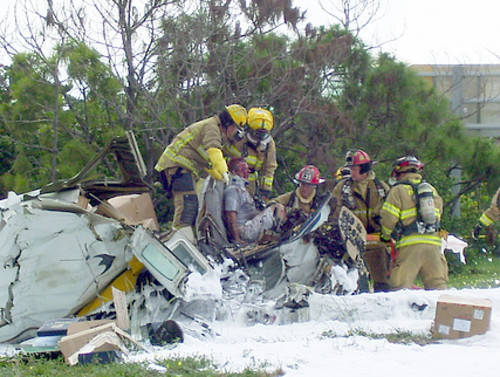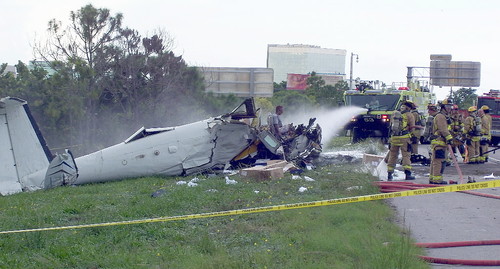NTSB Identification: NYC07FA234
Nonscheduled 14 CFR Part 135: Air Taxi & Commuter
Accident occurred Friday, September 21, 2007 in Ft. Lauderdale, FL
Aircraft: Beech H-18, registration: N123MD
Injuries: 1 Serious.
This is preliminary information, subject to change, and may contain errors. Any errors in this report will be corrected when the final report has been completed.
On September 21, 2007, at 1326 eastern daylight time, a Beech H-18, N123MD, operated by Monarch Air Group, LLC, was destroyed when it impacted terrain during a forced landing after takeoff from Fort Lauderdale Executive Airport (FXE), Fort Lauderdale, Florida. The certificated airline transport pilot, was seriously injured. Visual meteorological conditions prevailed for the cargo flight, destined for Pindling International Airport (MYNN), Nassau, Bahamas. A visual flight rules flight plan was filed for the flight conducted under 14 CFR Part 135.
According to witness statements, the airplane departed runway 8, and the pilot reported that he could not maintain altitude. The plane was then observed to drift to the south (right) of the extended runway centerline, at an approximate altitude of 150 feet above ground level (agl), and the tail appeared to be "wagging" side to side. The airplane then approached Interstate 95 (I-95) at approximately a 30-degree angle, and slightly west of a railroad right-of-way. It then appeared to enter an uncoordinated turn, and the tail of the airplane appeared to skid to the left. The right wing then dropped and the plane rolled "rapidly" to its right at 50 to 75 feet agl. The nose pitched up and the plane appeared to "hang" for a second" with the right side of the fuselage parallel to the direction of travel, "slightly nose up." A "puff" of smoke was observed as the right wingtip disappeared out of view, the nose then pitched down and the plane disappeared behind trees located along the edge of I-95. About 20 seconds later, smoke was observed rising from the area.
Examination of the accident site revealed that the airplane had impacted the northeast corner of a building with the right wing tip and a portion of the wing was torn away. The airplane then struck the railroad right of way, skipped off of the rails, impacted a chain link fence, and then the inclined swale adjacent to the southbound lane of I-95.
Examination of the main wreckage revealed a wreckage path heading of 157 degrees magnetic. The majority of the fuselage came to rest on a heading of 069 degrees magnetic. The nose section and nose gear wheel well had separated from the fuselage. The left wing had separated from its attach fittings, and was found adjacent to the fuselage. The right wing had also separated from its attach fittings, and was discovered forward of the main wreckage. The majority of the fuselage was found lying on its right side. The cockpit roof and sidewalls were separated from the cockpit floor, and the instrument panel was separated from its mounting location.
Examination of the cockpit revealed that the throttle control levers were in the full-throttle position. The mixture control levers were in the full-rich position, The propeller control levers were midrange, the landing gear handle was in the retracted position, and the wing flap handle was in the off position.
Examination of the engines revealed that that both had separated from their mounts. The left engine's propeller blades exhibited leading edge gouging and chordwise scratching, however, the right engine's propeller blades did not. Further examination of the right engine also revealed that the propeller blades were in the "feathered" position, and only one side of the spinner was crushed. No evidence of any preimpact malfunctions of either engine was discovered. Examination of the right engine's fuel strainer, engine driven fuel pump, and carburetor float bowl revealed that they were devoid of fuel.
Examination of the fuel system, however, revealed that fuel was present in the wing tanks. The left auxiliary wing tank was full and the left main wing tank was half full. The right auxiliary wing tank had been breached, and the right main wing tank was full. Approximately 245 gallons of 100LL aviation gasoline was recovered from the airplane. A fuel sample of the recovered fuel revealed no evidence of contamination.
No evidence of any preimpact malfunctions of the fuel system was discovered. The right engine fuel selector was found, however, positioned between the "99 GAL RIGHT MAIN" detent and the "60 GAL RIGHT AUX" detent. When the right engine fuel selector valve was examined, it was discovered that fuel was present in the fuel lines which led from the right main wing tank, and from the right auxiliary wing tank, to the valve. No fuel was discovered in the outlet port or the fuel line, which led from the valve to the engine.
According to Federal Aviation Administration (FAA) records, the pilot held an airline transport pilot certificate with multiple ratings, including airplane multi-engine land. He reported 3,400 total hours of flight experience on his most recent application for a FAA first-class medical certificate, dated May 7, 2007.
According to FAA and maintenance records, the airplane was manufactured in 1964. The airplane's most recent 100 hour inspection was completed on March 26, 2007, and at the time of the inspection, it had accumulated 13,066 total hours of operation.
The reported weather at FXE, 13 minutes after the accident, included: wind 120 degrees at 8 knots, visibility 10 miles, thunderstorms and light rain showers, few clouds at 3,700 feet, temperature 86 degrees Fahrenheit, dew point 74 degrees Fahrenheit, and an altimeter setting of 29.94 inches of mercury.
Here's the final:
http://www.ntsb.gov/aviationquery/brief.aspx?ev_id=20071009X01533
NTSB Identification:
NYC07FA234
Nonscheduled 14 CFR Part 135: Air Taxi & Commuter
Accident occurred Friday, September 21, 2007 in Ft. Lauderdale, FL
Probable Cause Approval Date: 08/13/2009
Aircraft: BEECH H-18, registration: N123MD
Injuries: 1 Serious.
NTSB investigators either traveled in support of this investigation or conducted a significant amount of investigative work without any travel, and used data obtained from various sources to prepare this aircraft accident report.
The airplane's right engine experienced a complete loss of power immediately after takeoff and the airplane began to slow. The airplane reached an altitude of approximately 91 feet above ground level and then entered an uncontrolled descent consistent with the onset of a velocity minimum control (Vmc) roll to the right. No evidence of any preimpact failures or malfunctions with either the engine or airframe was discovered, and evidence at the scene indicated that the landing gear had been retracted and the right engine propeller feathered. Examination of the cockpit revealed the right engine fuel selector was positioned between the "60 GAL RIGHT AUX" detent and the "RIGHT ENG OFF" detent. Examination of the fuel system between the selector and the right engine indicated that it was in this position prior to impact. Also, placards next to the fuel selectors stated, "WARNING POSITION SELECTORS IN DETENTS ONLY. NO FUEL FLOW TO ENGINES BETWEEN DETENTS." The pilot loaded the majority of the cargo and performed the weight and balance calculations. Examination of the fuselage revealed that all six cargo bins were full. The investigation also discovered that the furthest aft bin contained 265 pounds of cargo even though placarded for a maximum of 75 pounds. All other bins were loaded considerably below their maximum weight limits. Weight and balance calculations revealed the information listed on the weight and balance form produced by the pilot was erroneous and that the actual center of gravity (CG) of the airplane was rear of the aft CG limit, which would have created instability in the handling characteristics of the airplane, especially after a loss of engine power. In addition, the aft-of-limit CG would have increased the airspeed needed to prevent the airplane from entering a Vmc roll. Performance calculations indicate that with the right engine having lost power immediately after takeoff, the airplane would most likely not have been able to continue the departure on one operating engine.
The National Transportation Safety Board determines the probable cause(s) of this accident to be:
A total loss of engine power due to fuel starvation as a result of the pilot's failure to place the fuel selector for the right engine in the proper position. Contributing to the accident was the improper loading of the cargo.



